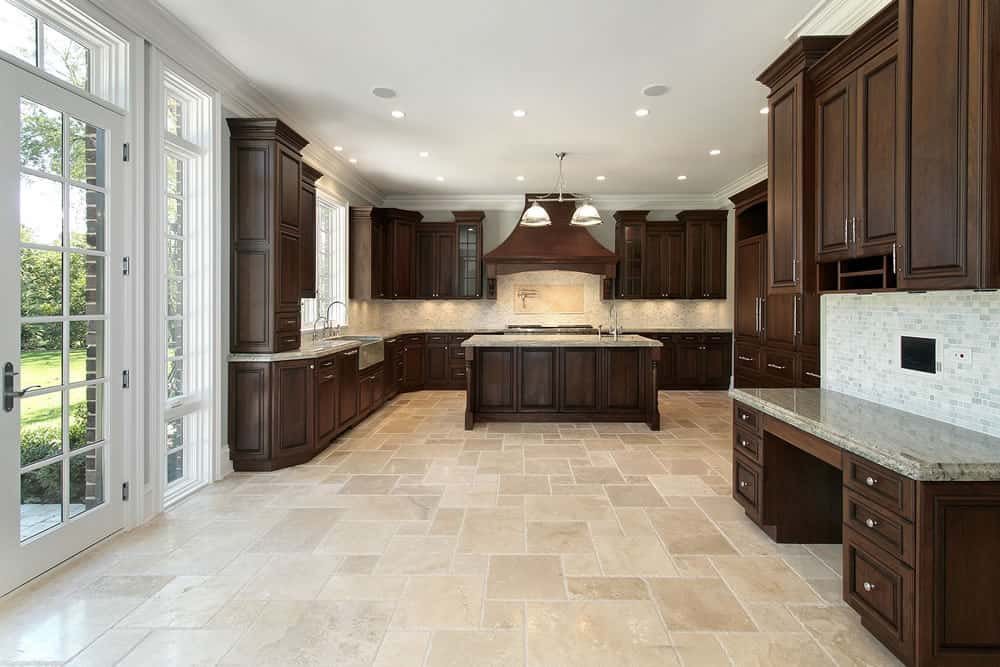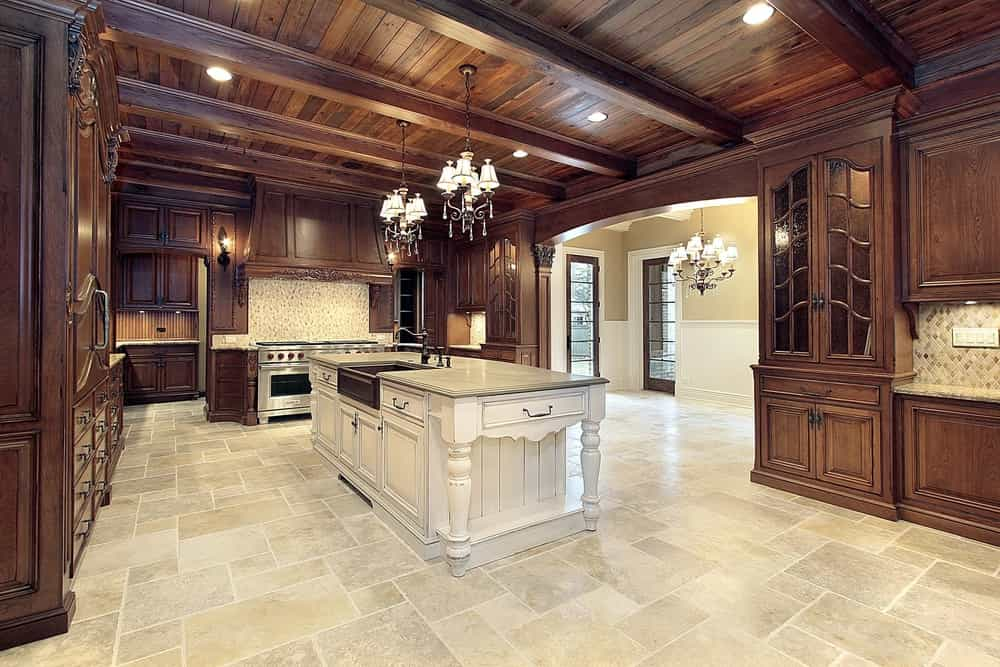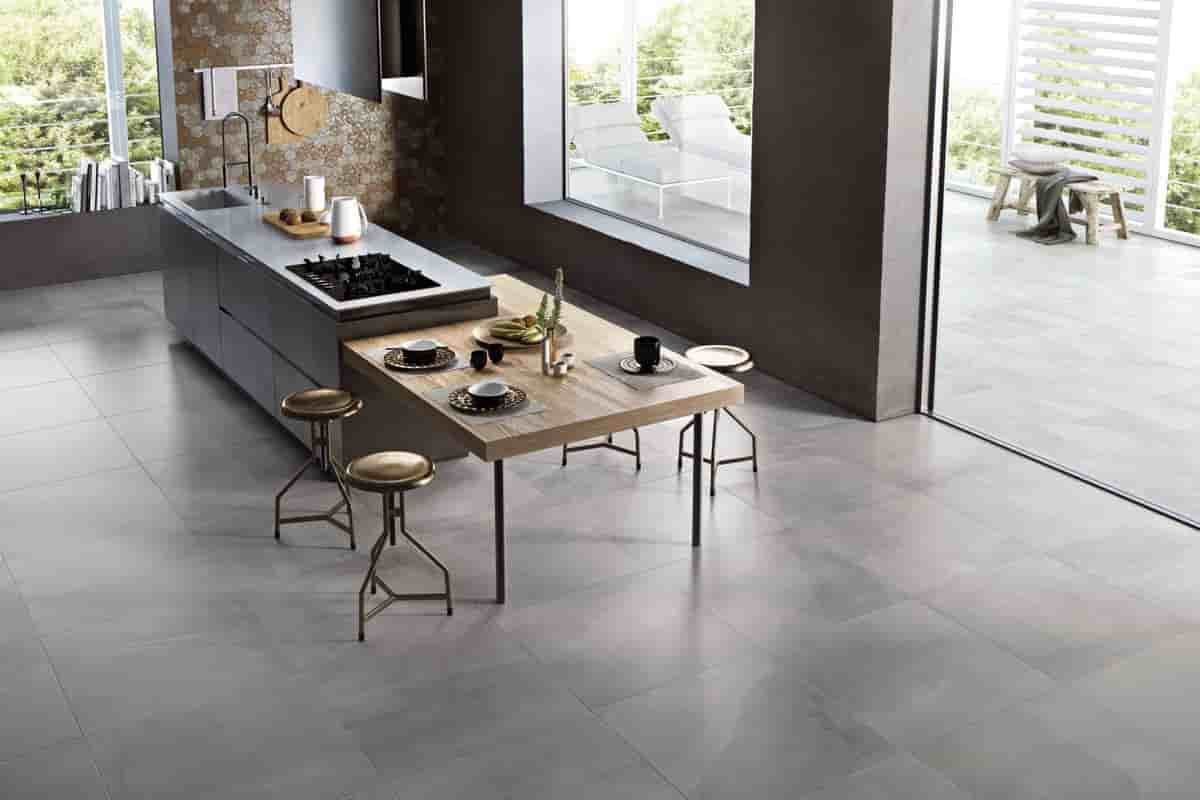Considering that a kitchen floor is one of the surfaces in a house that sees the most wear and tear, installing porcelain tiles with a dimension of 400 mm is a good and suitable choice to pursue.
How does porcelain tile compare to other kinds of flooring when it comes to places with high foot traffic levels? Not only does it need to be able to withstand heavy foot traffic, but it also can’t be difficult to clean and shouldn’t harbor any germs.
A fashionable kitchen, in addition to one that is practical, requires a floor that not only matches but also completes the kitchen’s overall appearance. It is not sufficient for a flooring material to only be functional; it also has to look appropriate.

Read on for a list of eight wonderful advantages to utilizing porcelain tiles on your kitchen floor if you are contemplating doing so. Porcelain tiles are quite adaptable.
- ELEGANT DURABILITY AND LONGEVITY
Porcelain tiles are the best option if you want a tile that will endure far longer than regular ceramic tiles. Because of the much greater temperature at which they are burned, they are far more durable than ceramics.
The very high density of a porcelain tile contributes to the material’s inherent resistance to water. Because of its high level of strength and durability, as well as its moisture-resistant surface, it is an awesome choice for use as a floor tile in high-traffic, high-wearing areas such as the kitchen.
Tiles made of porcelain with a good quality may endure anywhere from 15 to 20 years. Tiles with a high rating will retain their attractive appearance for up to 50 years.
- Effortless Maintenance and Hygiene
To maintain their pristine appearance, porcelain tiles need just a light sweeping or a quick once-over with a mop. The fact that they are inherently resistant to stains eliminates the need to seal them.
This is one of the primary reasons why individuals choose to install porcelain tiles rather than carpets in their homes. Because porcelain tiles are unaffected by common home cleaners, it is possible to sterilize and clean them thoroughly without risking any kind of harm.

Even if strong chemicals are employed, they won’t be harmed in any way and won’t be able to soak up the toxins either.
- REDUCE THE RISK OF FIRE
The potential for a fire to initiate in the kitchen is greater than in any other area in the house. Porcelain tiles are fire-resistant. They are not going to catch fire as laminates do, nor will they emit poisonous vapors or smoke like laminates do.
Porcelain wood tile will provide you with the appearance of a hardwood floor in the kitchen, but without the inherent dangers of real wood. This is an ideal solution for anybody who loves the beauty of a wooden floor in the kitchen but would like to go with a more secure choice.
- Areas with heavy traffic
Foot traffic causes surfaces to show indications of wear and tear rapidly. Porcelain tiles are a great option for high-traffic areas like entryways and long hallways due to their durability and ability to withstand heavy foot traffic without losing their clean beauty.
Wood-grain porcelain tile in the kitchen and dining room creates a feeling of continuity while also lending an air of refined sophistication to the two rooms. The area is made brighter and easier to move through thanks to the reflections of the lights in the ceiling.
The elegance of this little area can be kept looking fresh and modern with very little ongoing maintenance.
- FADE-FREE DESIGN
The designs on porcelain tiles will not wear out even when exposed to sunshine. They may be laid outside as floor tiles without the worry that the pattern would become unrecognizable after being subjected to the effects of weather.
Even sunlight that is diffused by glass windows may cause patterns on normal floor surfaces to become less distinct with time. There is no need to worry about fading when you choose porcelain tiles from MSI Aria Oro since they have understated marbled designs.

These rich, but subtle tiles in a cream hue highlight the area’s elegance and mimic the warmth of the natural wood used in the wonderfully carved bar stools. Additionally, the tiles are a perfect complement to the room’s neutral color palette.
- RELIABLE IN THE FACE OF MOISTURE
Porcelain tiles are known to have a moisture absorption rate of 0.5, making them resistant to water damage. For this reason, they can be a great option for places that are often soiled and exposed to moisture, such as the flooring in a kitchen.
When used in small kitchens, the daring designs of the MSI Brina Floral Encaustic porcelain tiles provide an intriguing contrast to the muted color palette that is reflected in the cabinets, walls, and other decorative elements. Because porcelain tiles were used for the flooring, the area designated as the splash zone in this compact kitchen is protected from the effects of wetness.
- SLIP RESISTANCE
The high-gloss surface of porcelain tiles gives the impression that they are slippery, but the tiles are really created with a rough coating that prevents them from becoming slippery, especially in areas and regions where there is much moisture.
This rustic kitchen has porcelain tiles with a matte finish that were produced to seem very much like the real stone that was used in the rest of the kitchen. The use of muted neutrals helps to create an understated sense of coherence, which is emphasized by the use of the MSI Cloud porcelain stone effect flooring in the kitchen.
- TRANSCENDING IMITATION IN FAVOR OF INNOVATION
Speaking of porcelain tiles, it is good to know that they are available in a wide variety of styles, some of which include wood grain, a brick-like surface complete with grout lines, a matte stone illusion, or finely patterned marble. Wood-grain porcelain tiles are very popular.

Porcelain tiles have always been an excellent option for the kitchen because they combine the adaptability of design with the convenience of maintenance and durability of tiles. The natural wood tones of the cabinets are contrasted by the traditional brick floor effect that is provided by MSI Ivory Brickstone, which has soft sandy tones.
The brick-look porcelain tile on the flooring has a realistic appearance thanks to the diagonal grout lines, which also draw attention toward the island centerpiece that is located in the middle of the kitchen.
Porcelain Tile vs. Stone
What factors should be taken into strict consideration while choosing between stone and porcelain tile? Consider your financial constraints: the cost of installation for porcelain tile is lower than that for stone. Stone has to be maintained and resealed on a yearly basis in order to preserve its appearance.
The installation of a stone kitchen floor is an investment that will last a lifetime and won’t need a replacement for a very long time.
The ultimate carpeting for the kitchen
Porcelain tile may be used as a versatile and aesthetically pleasing flooring solution in both indoor and outdoor living areas. Porcelain tiles are becoming the material of choice very quickly for flooring since they are simple to clean and require little upkeep.
Consider utilizing porcelain tiles for your flooring if you value a combination of design flexibility, superior product quality, and a finished result that will endure for a very long time. Get in touch with us for information on our extensive selection of porcelain floor tiles.










Your comment submitted.